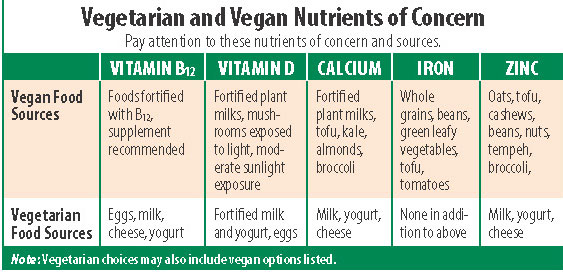Vegetarian vs. Vegan Diets
Before deciding which one's right for you, take a look at the details behind vegetarian vs. vegan diets.
Plant-based diets are growing in popularity, as people look to gain health and environmental benefits. According to the Vegetarian Resource Group, 3.3 percent of the population is vegetarian, and about half of those are vegan. Younger adults (18 to 34 years old) have the highest rate of vegetarianism (5.3 percent), suggesting continued growth on the horizon. So, what is the difference between these two eating styles? Why do people choose vegetarian vs. vegan diets, or vice versa?
Although many people have their own personal interpretation and adherence, here are the basics on each type of diet: what vegetarians will and won’t eat vs. what vegans will and won’t eat.
What Is a Vegan Diet?
A vegan diet excludes all animal foods, including animal flesh, dairy products (cheese, milk, yogurt, butter), eggs, and honey. While many foods—including milk, yogurt, and meat—are obviously non-vegan, there are many hidden animal ingredients in such foods as sauces, baked goods, and processed foods along with supplements.
Vegans also may avoid products associated with animals beyond the dinner plate. Examples: clothing, accessories, and cosmetics that are made with such animal products as leather, silk, or wool.
Vegetarian vs. Vegan Diets: The Main Difference
A vegetarian diet typically refers to a lacto-ovo vegetarian diet, which means a diet that excludes all animal flesh, but allows for dairy products and eggs. Hence, this eating pattern and lifestyle is less restrictive than a vegan diet, though it still may require attention to ingredients lists on food products and restaurant menus.
The Benefits
It has become increasingly clear that vegetarian and vegan diets both offer many benefits. The evidence is so solid that the Dietary Guidelines for Americans 2015–2020 suggests a vegetarian-style eating pattern as one of three diet patterns for optimal health. And the Academy of Nutrition and Dietetics reports that these diets, when appropriately planned, can be ideal for all ages and may reduce the risks of chronic disease and obesity.
The Adventist Health Study 2 compared five diet patterns (non-vegetarian, semi-vegetarian, pescatarian, vegetarian, and vegan) among 96,000 participants. Researchers discovered that, overall, the more plant-based the diet, the greater the benefit for conditions like body weight; blood cholesterol, insulin, blood pressure, and inflammation levels; and risks of cancer, heart disease, type 2 diabetes, and mortality.
There were even environmental benefits, researchers discovered. Vegetarians had a 28 percent lower carbon footprint than non-vegetarians, and vegans had a 42 percent lower carbon footprint. The bottom line: Go plant-based and reap the rewards.



 Ask the EN Experts March 2025
Ask the EN Experts March 2025  Vegan Diet Better Than Omnivore Diet for Cardiovascular Health
Vegan Diet Better Than Omnivore Diet for Cardiovascular Health 
Younger adults (18-34 years) have the highest rate of vegetarianism (5.3 percent), suggesting continued growth on the horizon.
© Joshua Resnick | Dreamstime